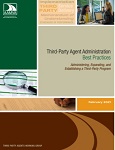Motor vehicle agencies throughout North America are increasing use of third-party agents to process motor vehicle and driver license transactions on behalf of their jurisdictions. In some jurisdictions, the agencies are required to use a third party, such as local government entities. In other jurisdictions, the use of third parties is a long-established tradition and an integral component of the service delivery system. Whether administering or expanding an existing program or implementing an entirely new program, a strong framework under which the third parties will operate is vital to a successful program.
Ideally, a third-party agent program fulfills a known service-level need. Agents might be the primary service delivery system for some jurisdictions, either because of the benefits the program provides or because of legislative mandates. In other jurisdictions, the agents provide ancillary or specialized services to a specific customer set, such as dealers, or to a limited geographical location. Therefore, it is important to consider the program goals when establishing or expanding a program.
Jurisdictions grant authority to agents to act on their behalf for specified services or transactions but ultimately oversee the accuracy and completeness of driver and/or vehicle data and transactions. The jurisdiction’s administrative responsibility needs to be conveyed to the agents through statutory and contract language that is clear and thorough. Jurisdictions recognize the importance of these steps because the public perception of the jurisdiction may suffer from errors or misuse in the fulfillment of transactions even if they were completed by an agent. The contract or memorandum of understanding (MOU) with the agent or vendor sets the basis of and forms the foundation for fulfilling the operational goals of the program.
AAMVA jurisdictions use third-party agents (agents) to perform driver and/or motor vehicle transactions on behalf of the motor vehicle administration and in compliance with jurisdiction statutes and rules. In some jurisdictions, these agents are the primary service delivery networks for the motor vehicle administration. In other jurisdictions, these agents provide ancillary or specialized services to a specific customer set, such as dealers, or to a specific geographical location. As more jurisdictions expand the offering of services and service delivery options for agents, the AAMVA community recognizes the need for a reference document to share best practices and serve as a resource to enhance the implementation and operation of third-party programs for both the jurisdictions and the agents.
 Download
Download
Ideally, a third-party agent program fulfills a known service-level need. Agents might be the primary service delivery system for some jurisdictions, either because of the benefits the program provides or because of legislative mandates. In other jurisdictions, the agents provide ancillary or specialized services to a specific customer set, such as dealers, or to a limited geographical location. Therefore, it is important to consider the program goals when establishing or expanding a program.
Jurisdictions grant authority to agents to act on their behalf for specified services or transactions but ultimately oversee the accuracy and completeness of driver and/or vehicle data and transactions. The jurisdiction’s administrative responsibility needs to be conveyed to the agents through statutory and contract language that is clear and thorough. Jurisdictions recognize the importance of these steps because the public perception of the jurisdiction may suffer from errors or misuse in the fulfillment of transactions even if they were completed by an agent. The contract or memorandum of understanding (MOU) with the agent or vendor sets the basis of and forms the foundation for fulfilling the operational goals of the program.
AAMVA jurisdictions use third-party agents (agents) to perform driver and/or motor vehicle transactions on behalf of the motor vehicle administration and in compliance with jurisdiction statutes and rules. In some jurisdictions, these agents are the primary service delivery networks for the motor vehicle administration. In other jurisdictions, these agents provide ancillary or specialized services to a specific customer set, such as dealers, or to a specific geographical location. As more jurisdictions expand the offering of services and service delivery options for agents, the AAMVA community recognizes the need for a reference document to share best practices and serve as a resource to enhance the implementation and operation of third-party programs for both the jurisdictions and the agents.
